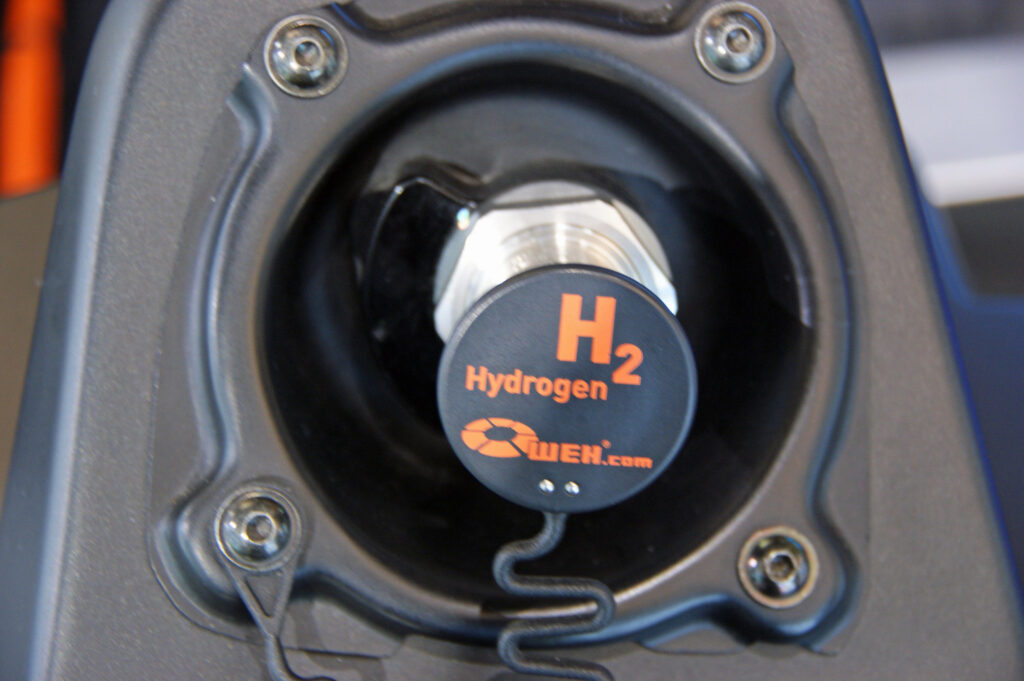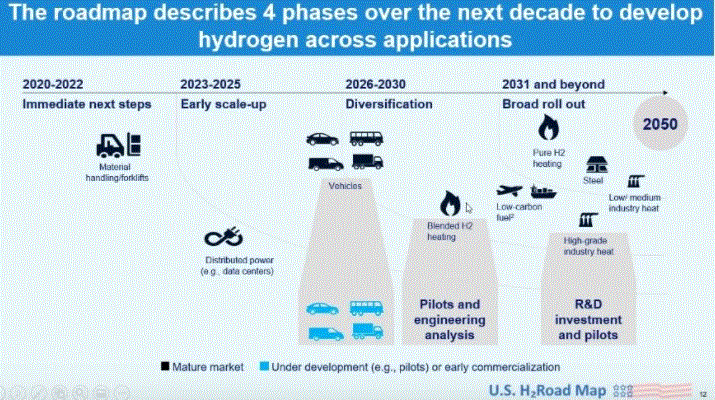By: Alan Mammoser
View the original article here

Announcements of plans and projects for hydrogen-based energy are appearing with scale and ambition in Europe and Asia. The United States, in contrast, is not seeing the same sort of headline-grabbing initiatives. But the United States is making quiet progress and laying the basis for what soon could emerge as a national strategy for hydrogen energy.
The European Union’s new “Hydrogen Strategy,” closely linked to its “Energy System Integration Strategy,” wants to create a large regional hydrogen market encompassing Eastern Europe and North Africa. Northeast Asia is on par with Europe regarding plans for hydrogen adoption. Japan’s far-reaching planning includes the import of “blue hydrogen” (produced with carbon capture) from major oil and gas exporting countries of the Middle East.
While the U.S. has not announced a major effort of this scale, significant progress is being made in envisioning and initiating a future “hydrogen economy.” The U.S. government is funding a dedicated initiative that focuses on emergent technologies and market development.
Meanwhile, a major industry group has published a realistic “roadmap” that sets out a 10-year timeline for new technology deployment and the opening of markets.
DOE does hydrogen
The US Department of Energy’s H2@Scale program, described as a “multi-year initiative to fully realize hydrogen’s benefits across the economy,” is a 4-year old initiative that is beginning to show results. It sees hydrogen as an integration technology that enhances the performance of diverse energy sources and plays a key role in facilitating a low carbon energy system.
During the past year, DOE channeled more than $100 million in grants to some 50 projects to further the H2@Scale initiative. They are funded through DOE’s Energy Efficiency and Renewable Energy Office (EERE), through its Hydrogen and Fuel Cell Technologies Office (HFTO) in cooperation with other EERE offices. Just last month, EERE announced about $64 million for 18 projects in fiscal year 2020.
The selected projects show great breadth and focus where technological development is required to broadly advance the deployment of hydrogen throughout the U.S. energy system. Taken together, they show the key role hydrogen is expected to play in de-carbonizing transport, heavy industry, energy storage and other energy-intensive sectors.
“6 projects are devoted to research and development on fuel cell technology and manufacturing of heavy-duty fuel cell trucks.”
Six projects are devoted to research and development on fuel cell technology and manufacturing of heavy-duty fuel cell trucks. There is support for private sector R&D on electrolyzer manufacturing, and for corporate and academic research on hydrogen storage, specifically high-strength carbon fiber for hydrogen storage tanks. There are two projects to spur demonstrations of large-scale hydrogen use at ports and data centers, and academic research on application of hydrogen for the production of “green steel.” One project is devoted to a training program for a future hydrogen and fuel cell workforce.
“H2@Scale is identifying new and emerging markets, where the integration of hydrogen technologies can add value,” says Sunita Satyapal, EERE HFTO director. “Some examples of these markets are data centers, ports, steel manufacturing, and medium and heavy-duty trucks.”
Satyapal says that projects are designed to bridge gaps in technology innovation, with demonstrations of how to turn hydrogen opportunities into real solutions. All research, development and demonstration under the purview of HFTO is guided by technical, performance and cost targets. The targets have been developed with industry input to ensure that new technologies will be competitive with incumbent technologies.
“Projects will emphasize strengthening the hydrogen supply chain through innovative manufacturing approaches and techniques,” she says.
“Projects will emphasize strengthening the hydrogen supply chain through innovative manufacturing approaches and techniques.”
In addition to the competitively selected and funded projects, over 25 H2@Scale projects are under lab cooperative agreements. The Cooperative Research and Development Agreements (CRADA) enable national laboratories to work with industry on key technical areas to advance H2@scale. A new call for CRADA projects recently was made with up to $24 million available for collaborative projects at national laboratories in two priority areas: hydrogen fueling technologies for medium- and heavy-duty FCEVs; and hydrogen blending in natural gas pipelines.
Industry input
“The U.S. Department of Energy’s H2@Scale program is crucial to enabling broader commercialization of transformational hydrogen and fuel cell technologies,” says Morry Markowitz, president of the Fuel Cell and Hydrogen Energy Association (FCHEA). “Many of these projects are advancing hydrogen applications in traditionally hard-to-decarbonize markets such as heavy-duty transportation, shipping propulsion and steel production.”
FCHEA, a Washington, D.C.-based industry association that seeks to promote commercialization and markets for fuel cells and hydrogen energy, has produced a comprehensive vision for a “Hydrogen Economy.” Its “Road Map to a U.S. Hydrogen Economy” looks at the full spectrum of potential applications: as a low-carbon (potentially zero-carbon) fuel for residential and commercial buildings; as an important fuel in the transportation sector; as a fuel and feedstock for industry and long-distance transport; as an important player in the power sector for power generation and grid balancing.
“An early opportunity is seen in states that have renewable energy standards, where the appropriate regulatory framework can allow hydrogen to begin to have a role in electric grid stability and storage.”
FCHEA’s road map may well prefigure an official strategy for hydrogen, should the U.S. government get serious about comprehensive planning and goal-setting for a low carbon energy future. It has four phases: 2020-22 (immediate steps); 2023-25 (early scale-up); 2026-30 (diversification); and beyond 2030 when the group would expect a “broad rollout” of hydrogen applications.
The immediate steps start with setting goals at state and national levels. They also focus on the best opportunities to scale mature applications, seeking cost reductions that will open new opportunities. An early opportunity is seen in states that have renewable energy standards, where the appropriate regulatory framework can allow hydrogen to begin to have a role in electric grid stability and storage.
In early scale-up, large-scale hydrogen production and demand starts to bring costs down. The road map sets specific goals for fuel cell electric vehicles (FCEVs), both light and heavy-duty, and calls for scaling up the fueling station network. Retrofitting of power generation will allow enhanced grid balancing while blending with natural gas for buildings also begins.
Diversification begins at mid-decade with some 17 million metric tons of low-carbon hydrogen fuel consumed annually and 1.2 million FCEVs sold. By the end of the decade the critical infrastructure is in place with the hard-to-decarbonize sectors of heavy industry and aviation being affected. An economy-wide carbon price will facilitate this expansion.
“This lofty vision for hydrogen will rely on strong government leadership and close cooperation with industry.”
Beyond 2030, the backbone infrastructure of hydrogen begins to appear at large-scale, with low-carbon hydrogen production, a hydrogen distribution pipeline network, and a large fueling station network across the U.S. By 2050, the adoption of hydrogen fuel cells for distributed power is standard, while on-site electrolyzers support local grids, energy storage and load balancing while providing hydrogen for fueling stations. In industry, low-carbon hydrogen is a widely used feedstock, produced either with carbon capture and storage or with dedicated renewables and on-site water electrolysis.
This lofty vision for hydrogen will rely on strong government leadership and close cooperation with industry. The FCHEA’s road map notes that European and Asian countries are investing in the groundwork for a future hydrogen economy. The group calls on the U.S. to not fall behind.


